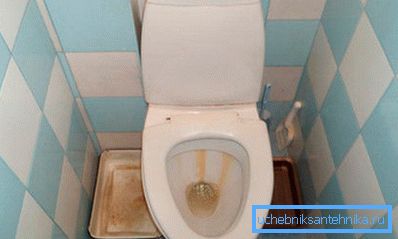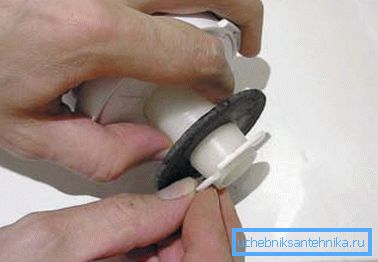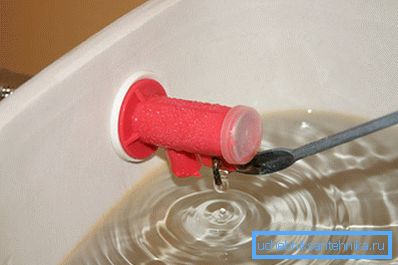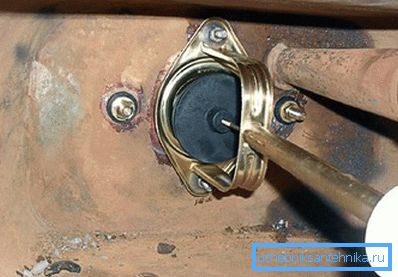What to do if water constantly flows in the toilet - useful
In the event that water constantly flows in the toilet, it brings little joy. An annoying noise interferes with falling asleep at night, moreover, there is rust in the bowl, and the pipes are covered with condensate.
On the readings of the water meter this is also not reflected in the best way. Therefore, there is a need to understand why water flows in the toilet, what can be done independently, without attracting specialists.

Causes of water leakage in the toilet

There are a number of reasons why water flows constantly from the toilet. To fix this, you need to understand the original source of this negative phenomenon. The following table will help you with this:
| Phenomenon | Cause |
| The tank overflow occurs, which leads to the fact that the excess water simply goes through the overflow. | Overflow can occur for a variety of reasons:
|
| The water level is not enough to overflow, and nevertheless, there is a leak. | Here the most typical cause is a rusted steel bolt tightening a shelf with a toilet. If the bolt is plastic, then it could simply burst. In the old tank constructions with brass seats, a couple more bolts were installed. Through them fixed the seat and gasket under it, located at the bottom of the tank. These bolts are destroyed over time, as rust inevitably eats them. |
| Water flows before reaching the overflow level, and the bolts are intact. | The problem is most likely a rubber bag. Lift the stem by the handle - the pear should also lift and then sit down. Over time, the rubber can lose its elasticity. The pear becomes rigid and no longer takes the form of a saddle, as a result of which water leaks in the toilet. |

Now that you have determined the cause, we now turn to how to fix the drainage of water in the toilet with your own hands. Depending on the nature of the leak, there may be several options to eliminate.
Tank overflows - what to do
When water constantly flows in the toilet - not everyone knows how to fix it. The answer is simple: eliminate tank overflow.
This instruction will help you:
- Remove the cover.
- Raise the float by one centimeter. In the event that the flow stopped with a little effort - the search for the cause can be completed. To eliminate the problem, you just need to bend the float lever a little.
- If the flow does not stop, it is necessary to inspect the valve itself.. Here you need to make sure that the locking lever of the float in the valve stud is intact and in place. At the same time, you will have to check if a hole has developed that holds the pin.

- When a pin is destroyed, it can be replaced with a piece of copper wire (thick). If the pin just loosened up in the hole being drilled, then it is necessary to replace the valve itself.
Tip! Going to the store for the valve, do not forget to take the old sample. There are as many varieties of valves on the market today as there are pipes for sewage systems.
- The valve should also be replaced if the flow does not stop even when the gasket is pressed tightly against the valve hole. Here the problem may be both in the gasket and in the valve body, but since the gaskets are not sold separately, you will have to replace the valve itself.
If water is not enough to overflow
If water is constantly flowing in the toilet, without reaching the level of overflow, the problem is solved as follows:
- We are convinced that water flows before reaching the overflow level.
- Carefully inspect the valve. If the tank has been in operation for several years, then it is best to buy a new set of valves, the price of which is low.

- Now it is necessary to carry out a complete assembly / disassembly of the tank. To do this, turn off the water supplied to the tank.
- Wash off the water so that the tank is empty.
- Disconnect the flexible eyeliner.
- We unscrew the bolts, by means of which the shelf is attached to the toilet. In the event that they are rusty, they should be cut with a hacksaw or impeller.
- After giving the tank back, take out the shelf from the cuff, which connects it to the toilet.
- Drain the remaining water, then put the item on a flat surface.
- Do not touch the flush toilet valve with float. The rest is necessary to disassemble, using open-end wrenches or adjustable wrenches.
Note! All rusted bolts must be cut with a hacksaw.
- Repeat all actions in reverse order. We replace the rubber gaskets even if you decide to leave the old fittings.
How to eliminate a leak if the water in the tank does not go beyond the level, and the bolts are intact
In such a situation, the ideal solution would be to replace the pear. It is necessary to unscrew it counterclockwise. A new pear should be the softest in order to block access to water as much as possible.

Tip! As a temporary solution, a load can be used that is suspended from the rod and presses the pear against the saddle.
Conclusion
As you can see, there is nothing difficult in eliminating the leakage of water in the toilet. As a diagnosis of damage, and its removal can be done independently. More information you can get by watching the video in this article.